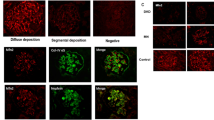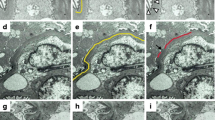Abstract
Purpose
This study was to investigate the relation between the number of autophagosomes in podocytes and the syndromes of idiopathic membranous nephropathy (IMN) and secondary membranous nephropathy (sMN).
Methods
The pathological changes in the kidney tissues of patients were detected with the hematoxylin and eosin staining, the periodic acid–Schiff reagent treatment, the Masson’s trichrome staining and the immunofluorescence detection (IF). Meanwhile, the autophagosomes in podocyte were analyzed by transmission electron microscopy and the IF assay pointing to LC3-II, an autophagic marker. Clinical data, including age, sex, edema, serum creatinine, estimated glomerular filtration rate, hematuria, urine protein excretion and serum albumin, were collected from in-patient medical records. Finally, the association of podocyte autophagosome numbers with idiopathic membranous nephropathy and secondary membranous nephropathy was studied.
Results
Fewer autophagosomes were observed in podocytes of nephropathy group compared with the control group. Moreover, there was a significant difference in the autophagosome number between the two types of MN and each kind of nephropathy demonstrated distinct characteristics. Although the reduced autophagosome number in the IMN cases was not related to sex, this trend was exacerbated along with the progression from pathological stage I to II. In contrast, fewer autophagosomes were observed in class II and V LN patients compared with the controls, while greater numbers were detected in class III and IV LN patients.
Conclusions
The results indicated that the autophagy participated in the podocyte injury in IMN and sMN and the number of autophagosomes in podocytes was related to the pathological classification.





Similar content being viewed by others
References
Lv Qianying, Yang Fengjie, Chen Kun et al (2016) Autophagy protects podocytes from sublytic complement induced injury. Exp Cell Res 341:132–138
Eiser J, Sever S (2013) Podocyte biology and pathogenesis of kidney disease. Annu Rev Med 64:357–366
Ronco P, Debiec H (2012) Pathogenesis of membranous nephropathy: recent advances and future challenges. Nat Rev Nephrol 8:203–213
Wang L, Hong Q, Lv Y, Feng Z et al (2012) Autophagy can repair endoplasmic reticulum stress damage of the passive Heymann nephritis as revealed by proteomics analysis. J Proteom 75:3866–3876
Hartleben B, Godel M, Meyer-Schwesinger C (2010) Autophagy influences glomerular disease susceptibility and maintains podocyte homeostasis in aging mice. J Clin Invest 120:1084–1096
Cinà DP, Onay T, Paltoo A et al (2012) Inhibition of MTOR disrupts autophagic flux in podocytes. J Am Soc Nephrol 23:412–420
Wu L, Feng Z, Cui S et al (2013) Rapamycin upregulates autophagy by inhibiting the mTOR–ULK1 pathway, resulting in reduced podocyte injury. PLoS ONE 8:e63799
Weening JJ, D’Agati VD, Schwartz MM et al (2004) The classification of glomerulonephritis in systemic lupus erythematosus revisited. J Am Soc Nephrol 15:241–250
Zheng CX, Chen ZH, Zeng CH et al (2008) Triptolide protects podocytes from puromycin aminonucleoside induced injury in vivo and in vitro. Kidney Int 74:596–612
Zeng Caihong, Fan Yun, Junnan Wu et al (2014) Podocyte autophagic activity plays a protective role in renal injury and delays the progression of podocytopathies. J Pathol 234:203–213
Radice A, Trezzi B, Maggiore U et al (2016) Clinical usefulness of autoantibodies to M-type phospholipase A2 receptor (PLA2R) for monitoring disease activity in idiopathic membranous nephropathy (IMN). Autoimmun Rev 15:146–154
LijuYn T, Jing Y, Xianglei K et al (2016) Increasing prevalence of membranous nephropathy in patients with primary glomerular diseases: a cross-sectional study in China. Nephrology (Carlton). doi:10.1111/nep.12739
Björn H, Markus G, Catherine MS et al (2010) Autophagy influences glomerular disease susceptibility and maintains podocyte homeostasis in aging mice. J Clin Invest 120(4):1084–1096
Pavlisko EN, Howell DN (2013) The continued vital role of electron microscopy in the diagnosis of renal disease/dysfunction. Ultrastruct Pathol 37:1–8
Mizushima N, Levine B, Cuervo AM et al (2008) Autophagy fights disease through vellular self-digestion. Nature 451(7182):1069–1075
Tagawa A, Yasuda M, Kume S et al (2016) Impaired podocyte autophagy exacerbates proteinuria in diabetic nephropathy. Diabetes 65(3):755–767
Tangli X, Xu G, Ling N et al (2014) Rapamycin promotes podocyte autophagy and ameliorates renal injury in diabetic mice. Mol Cell Biochem 394:145–154
Acknowledgments
This study was funded by the National Natural Science Foundation (Grant Number 81641026), the Provincial Foundation Project (Grant number WKJ2013-2-002), the Major Projects of Science and Technology Department of Zhejiang Province (Grant Number 2014C03047-2), the General Project of the Medical and Health of Zhejiang Province(Grant Number 2015KYA025), the Project of Scientific research Foundation of Chinese Medicine (Grant Number 2015ZA011), the Natural Science Foundation of Zhejiang Province (Grant Number LY16H050005) and Zhejiang Provincial Program for the Cultivation of High-level New Health Talent (Grant Number 2013).
Author information
Authors and Affiliations
Corresponding authors
Ethics declarations
Conflict of interest
The authors declare that they have no conflict of interest.
Ethical approval
All procedures performed in studies involving human participants were in accordance with the ethical standards of the institutional and national research committee and with the 1964 Declaration of Helsinki and its later amendments or comparable ethical standards.
Informed consent
Informed consent was obtained from all individual participants included in the study.
Rights and permissions
About this article
Cite this article
Jin, J., Zhan, H., Lin, B. et al. Association of podocyte autophagosome numbers with idiopathic membranous nephropathy and secondary membranous nephropathy. Int Urol Nephrol 49, 1025–1031 (2017). https://doi.org/10.1007/s11255-017-1555-5
Received:
Accepted:
Published:
Issue Date:
DOI: https://doi.org/10.1007/s11255-017-1555-5




